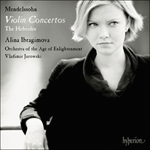The Violin Concerto in D minor (1822) was composed when Mendelssohn was only thirteen and is dedicated to his friend and violin instructor, Eduard Rietz. In three movements (fast–slow–fast), it is scored for string orchestra, and betrays two diverse influences. First is the French violin school of Viotti and his Parisian followers, among them Pierre Rode, Pierre Baillot (with whom the young Mendelssohn had studied in Paris in 1816), and Rodolphe Kreutzer. And second is the influence of C P E Bach and the North German school of string symphonists. The three movements suggest a clear historical progression, beginning with the first that, with its angular, interrupted melodic lines, recalls the mannered
empfindsam (ultra-sensitive) style of C P E Bach. Quite in contrast is the opening of the slow movement, based on a theme at once serenely classical, and Mozartian in its poise. The finale, a brisk rondo in a popular style, bristles with solo figurations that reflect the virtuoso styles of Mendelssohn’s own time.
from notes by R Larry Todd © 2012
Le Concerto pour violon en ré mineur (1822), composé par un Mendelssohn âgé de seulement treize ans, qui le dédia à son ami et professeur de violon Eduard Rietz, est écrit en trois mouvements (rapide–lent–rapide) pour orchestre à cordes et trahit une double influence. D’abord, celle de l’école française de violon de Viotti et de ses tenants parisiens, dont Pierre Rode, Pierre Baillot (avec qui le jeune Mendelssohn avait étudié à Paris en 1816) et Rodolphe Kreutzer. Ensuite, celle de C. P. E. Bach et de l’école d’Allemagne du Nord des symphonistes à cordes. Chacun des trois mouvements suggère une nette progression historique: le premier, avec ses lignes mélodiques anguleuses, interrompues, rappelle le maniérisme
empfindsam (ultrasensible) de C. P. E. Bach; aux antipodes, l’ouverture du mouvement lent, qui s’appuie d’emblée sur un thème sereinement classique, présente un maintien mozartien; quant au finale, un alerte rondo en style populaire, il grouille de figurations solo reflétant les styles virtuoses de l’époque mendelssohnienne.
extrait des notes rédigées par R Larry Todd © 2012
Français: Hypérion
Das Violinkonzert d-Moll (1822), von Mendelssohn mit nur dreizehn Jahren komponiert und seinem Freund und Geigenlehrer Eduard Rietz gewidmet, besteht aus drei Sätzen (schnell–langsam–schnell), ist für Streichorchester geschrieben und verrät zwei unterschiedliche Einflüsse: zum einen die französische Violinschule Viottis und seiner Pariser Schüler—darunter Pierre Rode, Pierre Baillot (bei dem der junge Mendelssohn 1816 in Paris Unterricht genommen hatte) und Rodolphe Kreutzer—, zum anderen C. Ph. E. Bach und die Komponisten der norddeutschen Streichersinfonie-Schule. Deutlich zeichnen die drei Sätze eine historische Entwicklung nach, angefangen mit den vertrackten und sprunghaften Melodielinien des Kopfsatzes, die an den empfindsamen Stil von C. Ph. E. Bach erinnern. Einen deutlichen Gegensatz dazu bildet der Beginn des langsamen Satzes, dem ein Thema von zugleich abgeklärter Klassizität und mozartischer Gelassenheit zugrunde liegt. Das Finale, ein schwungvolles Rondo im Volkston, strotzt nur so vor solistischen Verzierungen und verweist damit auf die virtuosen Stilformen zu Mendelssohns eigenen Lebzeiten.
aus dem Begleittext von R Larry Todd © 2012
Deutsch: Arne Muus


 Mendelssohn: Violin Concertos
Mendelssohn: Violin Concertos Mendelssohn: Violin Concertos - Vinyl Edition
Mendelssohn: Violin Concertos - Vinyl Edition
